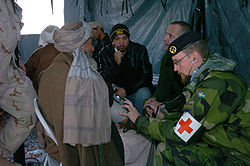War in Afghanistan (2001–2021)
Template:War in Afghanistan (2001–2021) infobox
The War in Afghanistan was a war fought by the United States, the United Kingdom, Canada, The Netherlands, Australia and other countries against the Taliban and al-Qaeda, after the September 11 attacks against the United States on September 11, 2001.[1]
On 31 August 2021 (local time), the war ended as the last coalition soldiers (from foreign countries), left Afghanistan.[2][3]
History
The war started when the United States invaded Afghanistan in 2001.[4] The US and its allies forced the Taliban and Al-Qaeda to hide in the mountains. In December 2001, the US and its allies founded a new government for Afghanistan. Its president was Hamid Karzai.
By February 2002, 5,000 soldiers from ISAF (or International Security Assistance Force) were in Afghanistan.[5] That military force was led by United States. ISAF's soldiers were on loan from the militaries of NATO countries and allied countries. In 2012 ISAF was at its maximum: 130,000 soldiers (in Afghanistan).[6]
In 2004 Hamid Karzai started as the first president of the Islamic Republic of Afghanistan.[7] Even though the Taliban had lost power, they formed a "shadow government". Taliban insurgents, or fighters, controlled many parts of Afghanistan, and enforced their own laws.[8]
Osama bin Laden was killed in Pakistan, May 2011.
British troops left Afghanistan in 2015, after 5 years of training the Afghanistan police to deal with threats from the Taliban.[9]
After security deteriorated, American soldiers returned and over 10,000 were in the country at the end of 2017. In 2020, the US and NATO allies promised to leave Afghanistan as long as the Taliban agreed to certain things: not allowing terrorists to operate in its area, and starting peace talks with the Afghanistan government.[10] In mid-2021, the Taliban began a military offensive to enlarge their territory as US and allied forces began to leave. By August 15, 2021, the Taliban had recaptured Kabul and defeated the Afghan government.[11]
An anti-Taliban front took control of the Panjshir Valley, in August 2021 but lost control later that year due to the Taliban sending its forces.[12][13]
During the 2021 evacuation from Afghanistan, over 150,000 people chose to be taken out of Afghanistan; They were diplomats, other civilian staff, other civilians, and military staff.[14][15]
The last military airplanes of the United States, left the airport in Kabul, one minute before 31 August 2021.[16]
On 31 August 2021 (local time), the war ended.[2]
Deaths and injuries
More than 15,000 Coalition soldiers were wounded: 6,773 US,[17] 3,954 UK,[18][19] 1,500 Canadian[20] and over 2,500 other Coalition soldiers. 5,500 Afghan army soldiers and 200 Northern Alliance militants were killed in this war. 378 US civilian contractors were killed and 7,224.
Gallery
ISAF soldiers on loan from the Romanian Land Forces between Kandahar and Kabul in 2003
A soldier of the Afghan National Army in Kandahar Province in 2008
ISAF soldiers on loan from the Czech Republic's army in Logar Province in 2009
ISAF soldiers on loan from Germany's Bundeswehr near Mazar-i-Sharif in 2009
A howitzer of the Royal Netherlands Army in 2009
A helicopter of Britain's Royal Air Force in Helmand Province in 2015
Aeroplanes of the Afghan Air Force above Kabul in 2016
War In Afghanistan (2001–2021) Media
Ground Zero in New York following the September 11th attacks, September 2001
US Army Special Forces and US Air Force Combat Controllers with Northern Alliance troops on horseback in Samangan Province, 2001
A US Navy Corpsman searches for Taliban fighters in Mihtarlam, 2005
An Apache helicopter provides protection from the air, Lwar Kowndalan in Kandahar, 2005
Swedish Army medic in the Mazar-e Sharif region, 2006
References
- ↑ The U.S. War in Afghanistan. September 12, 2020. https://www.cfr.org/timeline/us-war-afghanistan. Retrieved October 27, 2020.
- ↑ 2.0 2.1 "The last US military planes have left Afghanistan, marking the end of the United States' longest war". 30 August 2021.
- ↑ Afghanistan Live Updates: The United States Occupation Is Over
- ↑ "Afghanistan: Why is there a war?" (in en-GB). BBC News. 2021-08-10. https://www.bbc.com/news/world-asia-49192495. Retrieved 2021-08-17.
- ↑ ISAF in Afghanistan Archived 12 June 2002 at the Wayback Machine CDI, Terrorism Project – 14 February 2002.
- ↑ "NATO sets "irreversible" but risky course to end Afghan war". Reuters. 21 May 2012. http://ca.reuters.com/article/topNews/idCABRE84J02C20120521?sp=true. Retrieved 22 May 2012.
- ↑ Neumann, Brian F. (2013). Operation Enduring Freedom. March 2002-April 2005. U.S. Army Center of Military History.
- ↑ Witte, Griff (2009-12-08) (in en-US). Taliban establishes elaborate shadow government in Afghanistan. . http://www.washingtonpost.com/wp-dyn/content/article/2009/12/07/AR2009120704127.html. Retrieved 2021-08-17.
- ↑ "U.S. Department of Labor - Office of Workers' Compensation Programs (OWCP) - Division of Longshore and Harbor Workers' Compensation (DLHWC) -". dol.gov.
- ↑ "Afghanistan: Biden calls for end to 'America's longest war'" (in en-GB). BBC News. 2021-04-14. https://www.bbc.com/news/world-us-canada-56750439. Retrieved 2021-08-17.
- ↑ Zucchino, David (2021-08-16). "The War in Afghanistan: How It Started and How It Is Ending" (in en-US). The New York Times. . https://www.nytimes.com/article/afghanistan-war-us.html. Retrieved 2021-08-17.
- ↑ "Taliban say they took Panjshir, last holdout Afghan province". AP News. 7 September 2021. Retrieved 27 March 2024.
- ↑ "Taliban claims it has control of Panjshir province, resistance says the fight goes on". France 24. 6 September 2021. Retrieved 27 March 2024.
- ↑ "Afghanistan: How many people have been evacuated by each country?". Sky News. Retrieved 28 August 2021.
- ↑ "Factbox: Evacuations from Afghanistan by country". Reuters. 27 August 2021. Retrieved 28 August 2021.
- ↑ https://www.reuters.com/world/india/rockets-fired-kabul-airport-us-troops-race-complete-evacuation-2021-08-30/. Retrieved 31 August 2021
- ↑ "US casualties" (PDF). United States Department of Defense.
- ↑ "Op Herrick". Archived from the original on 30 November 2012. Retrieved 20 April 2010.
- ↑ http://www.mod.uk/NR/rdonlyres/03645441-065E-4E0A-9F62-B8AEBDAC8151/0/opherrickcasualtytablesto15june2010.pdf
- ↑ Wark, Bruce. "1,580 Canadian soldiers injured and killed in Afghanistan". The Coast Halifax.



















